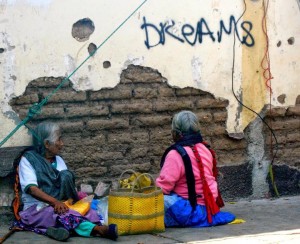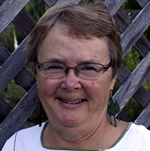I still feel guilty when I flush the toilet paper. That’s one thing that you must not do in Mexico! But when my mind clears, I’m reminded that you don’t have to put the mucky wad in the garbage here. My common sense assures me that our plumbing can handle it all just fine, and soothes me to know I won’t be mopping up a stinky flood. I’ve been home a month, and I am beginning to be able to flush without self-reproach. But I’m also reflecting on “coming home”. I’ve been a snowbird in San Miguel de Allende, right the middle of Mexico. Four months away from the Island, and my lifestyle here has led me to reflect on what’s the same, what’s different, and what my feelings are about being home. Here’s a sample.
I left hot, dry and brilliantly sunny Mexico before dawn, and by noon I was in the middle of a West Coast drizzle. Coming into Vancouver airport, my planeload of international arrivals walked through a clever diorama of the rainforest, getting a feel for this environment enroute to Customs. Streams gurgled underfoot and we were surrounded by dangling moss, thick forest, bird chirps and insect hums.
 What I noticed most were the native carvings and paintings, paying their unique homage to nature, and assuring visitors that Aboriginal people are valued here. As I hurried along, I reflected on the irony of this. Many of us, calling ourselves British Columbians, experience complex feelings about our First Nations neighbours. There are also stresses as the relationship waxes and wanes with the political atmosphere. For me, respect for the indigenous world view is part of my identity as an Island woman living on the shores of the Salish Sea. It’s pretty much the same in Mexico. The folk art of the Mayan or Huichol or Zapotec or hundreds of other indigenous groups is integral to Mexican identity. At the same time, indigenous people themselves face discrimination in myriad and subtle ways.
What I noticed most were the native carvings and paintings, paying their unique homage to nature, and assuring visitors that Aboriginal people are valued here. As I hurried along, I reflected on the irony of this. Many of us, calling ourselves British Columbians, experience complex feelings about our First Nations neighbours. There are also stresses as the relationship waxes and wanes with the political atmosphere. For me, respect for the indigenous world view is part of my identity as an Island woman living on the shores of the Salish Sea. It’s pretty much the same in Mexico. The folk art of the Mayan or Huichol or Zapotec or hundreds of other indigenous groups is integral to Mexican identity. At the same time, indigenous people themselves face discrimination in myriad and subtle ways.
I sailed through Customs, interacting with a kiosk that made churning noises each time I answered a question correctly, then snapped my picture. I missed the “welcome home” smile or snarl of a real person as my passport was stamped. Mexicans would never miss an opportunity to say bienvenido. They have many people in Customs to greet you. But one of them uses a machine to avoid that uncomfortable business of deciding who will get their luggage searched. So the Officer flashes a “glad you are here” smile and asks you to push a button. If it flashes green, you are waved onward. But if your luck is a red light, then be prepared for a thorough shakedown. I hate the red flash but prefer the interaction with a human asking me to push the button.
There was my husband, waving at the gate, soggy and wearing a heavy fleece. As we hugged, his dripping umbrella soaked my thin pants. “You are going to be cold”, he warned. And I was. For the first several days, I huddled by the fire or under my duvet. One of my reasons for spending the winter in Mexico is my aversion to the grey and clammy Island climate in winter. “I’m back too soon!”, I grumbled. And my aching arthritic joints affirmed this. I’m pleased to know that there is a place where Advil is not part of the winter routine.
It’s not just the difference between the comfort of thin cotton or the unfortunate need for fleece in May that I noticed. When I unpacked my suitcase – in the bathtub to foil hitchhiking insects – I stood glumly in front of my closet. I hung up my Mexican gear, my brilliant yellow skirt, bright red tunic, blouses in burgundy, cerulean and lime, next to my blacks, greys and khakis. The contrast between clothes that feel right here, and “there” clothes startled me. “Which is the real me?” I thought. And I wondered if I could change my Island vibe. After all, I’d been told more than once that my smiles on Facebook from San Miguel were, well, “sunnier” than my more serious mien on the Island. “Perhaps it’s time for a new version of myself”, I mused. “Clothes make the woman, after all”. So I tried on a new layered look, a long sleeve jersey for warmth under a filmy plum coloured blouse … for zest.
It always happens. When I pull into my driveway after a length of time away, I see it all. The cluttered garage, for example, shocked me as the big door scratched open and my husband chirped, “Welcome home!” I cringed. “Are we hoarders?” I choked. “Do we need all this stuff?” I had the same reaction to my overcrowded closet, my crammed drawers and my home office, overflowing with files harking back to times that are irrelevant to how I feel now. Most of all, the garden was filled with weeds. I studied their challenging lushness as I tried to relax in my mildewed lawn chair, and tried to re-frame them as a metaphor of my life. “Don’t just focus on the weeds! Admire the flowers bursting forth in every corner of the garden. They are what really counts!” Still, I spent my first weeks back on the Island in teeth clenched de-cluttering. The recycle guy just off the highway into Parksville said “you again?” as I arrived with the third load. The volunteers at SOS asked if I was moving. I reflected as I did all this that, like the robins returning in spring, the species “snowbird” is probably also driven by instinct to re-feather its nest when it returns from its migration. It’s one of the advantages of going away. Habits get ruffled. Misfits are easier to see, accept and maybe even deal with. For me, the weeds are next in line.
 Qualicum Foods was a pleasure and a shock. There were the same piles of deep red peppers, fat broccoli and glistening green avocados that are shipped up from Mexico for the gringo’s pleasure, but in my local Mexican tienda they also had a just-picked flavour. There on the bottom shelf at Qualicum Foods were the tortillas, now in plastic bags with best before dates. They don’t compare with those toasted just for me by the lady around the corner from my San Miguel gate. The skinny chickens on the electric rotisserie in the deli faded before my salivating memory of plump pullets roasting on the mesquite fires.
Qualicum Foods was a pleasure and a shock. There were the same piles of deep red peppers, fat broccoli and glistening green avocados that are shipped up from Mexico for the gringo’s pleasure, but in my local Mexican tienda they also had a just-picked flavour. There on the bottom shelf at Qualicum Foods were the tortillas, now in plastic bags with best before dates. They don’t compare with those toasted just for me by the lady around the corner from my San Miguel gate. The skinny chickens on the electric rotisserie in the deli faded before my salivating memory of plump pullets roasting on the mesquite fires.
Still, I enjoyed the efficiency of one-stop shopping in the local grocery. At the checkout, the sunnier me I want to become rejects that diffident “nice day” mind elsewhere, and now I try to have real exchanges about the flow of life that day. The cashiers and other service providers seem to like that, and we all feel better when we’re done.
What doesn’t feel better, though, are the food bills I’m presented with now. My typical little stash of goodies for just one day costs more than I would have paid in San Miguel for groceries lasting a week or more. Everything is expensive here. In Mexico, my lifestyle was not lavish, but I never held back from getting lots of everything I wanted. I revelled in concerts and courses and conferences, all of which had price tags. I took trips to see butterflies in the mountains and to sit on a perfect Pacific beach for a week. I enjoyed massages and pedicures and yoga, and even changed my hairstyle, twice! These services were all delivered in clean and pleasant surroundings, with well-trained providers who welcomed me by name. There were more restaurants and margaritas in my life in San Miguel than I would ever enjoy or afford on the Island. While my little casita was a considered a bargain compared to the haciendas owned or rented by other snowbirds, it still cost a hefty $600 US a month, by far my largest expense. Add in airfare and you would think that my indulgence to spend four months abroad would take a huge bite out of the family budget. But that’s the big surprise on my return. My bank account still looked just as healthy over the course of the four month period away than a similar length of time wafting my credit card around on the Island. Indeed, going to Mexico for the winter, even while leaving hubby spending happily away on the Island, was a cost saving measure to our family!
I’m wondering what other Island women notice, feel and do when they return from being away? Do others have smooth landings? Does being away provoke changes?
 Janet Dunnett
Janet Dunnett
Email Janet
See all articles by Janet Dunnett




Enjoyed your blog post, Janet. I had similar feelings after my first trip to Cuba during their “Special Period”, following the collapse of the Soviet Union. Food, fuel and construction materials were in short supply and Cubans were struggling to keep themselves and their families fed and clothed. Still they opened their hearts and homes to us, asking nothing in return.
Gracias … a very thoughtful … thought-provoking essay. Moving out of the familiar, embracing the foreign and returning can cause the once familiar to appear foreign. You engaged me in a visual travel piece while at the same time challenging me with provocative life questions. Keep writing … I want to read more.
You nailed it! I too have returned to see the clutter and been desperate to clear it. Embraced the bold colours and wanted to wear them. You’ve articulated the experience of ‘fresh eyes’ and authenticated the inner-self. Coming home is one of the reasons travel is so broadening.